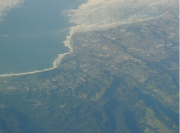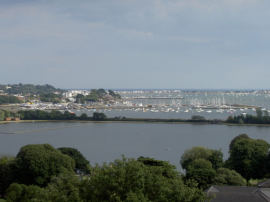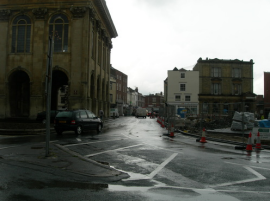Abiodun
Abiodun is a large town, port and tourist destination in Candelaria And Marquez, situated on south-east coast of the island of Candelaria. The original town of Abingdon – which is how the city is still, and has apparently always been, pronounced – was founded in 1809; making it one of the oldest settlements in the British Candelarias. The awkward terrain of Candelaria, even on the coasts, made expansion difficult; and Abingdon became just one of numerous small fishing villages. Later British settlements to the north, particularly around what would become the Albrecht Cove and in the north-east, met with rather greater success; though for much of the early nineteenth century Abingdon was considered a notable port, with an important part to play in the wool trade. Greater urbanisation and industrialism saw the town’s port status become rather more important in the later nineteenth century; a time which also saw the fanciful adoption of ‘Abiodun’ as the town’s official name. As a spelling it stuck, but the proposed pronunciation never caught on. The strength of Albrecht, Arrigo, Bass, Bove, Zapata et al as ports in the islands, coupled with the Abiodun region’s shallow waters, saw the townsfolk look towards other industries to maintain the town’s burgeoning wealth. The beaches and landscape of the region began to attract increasingly large numbers of tourists throughout the late nineteenth century; with tourism eventually becoming, after the service sector, the town’s greatest area of </div>employment. A wide range of other forms of employment are available however, mostly in heavy-goods construction but also cosmetics, publishing, banking and, of course, fishing.As well known nationally as the town itself is the south-western costal district of Gamboa. An area of early mercantile prosperity while other parts of the town were rapidly becoming overcrowded and poverty stricken; Gamboa has retained a status as the home of costal Candelarian affluence ever since. Today, it remains the most expensive and exclusive district in the entire country, its main road (‘millionaire’s row’) having one of the highest land values, by area, in the entire region even despite C&M’s high taxation. Though not all of Gamboa is quite as salubrious as that part labelled as the Candelarias’ “Orange County”; the district as a whole is still very wealthy. It boasts C&M’s most popular sailing and yachting clubs, though Candelariasians of all social backgrounds are able to make use of its beaches and crystal-clear waters for watersports of all types. FootballAbiodun, it shouldn’t surprise you to discover, is also well known nationally for its football clubs. Abiodun North</div>Abiodun North FC and Abiodun South FC were both formed in the same year, 1939, after the existing Abiodun FC split acrimoniously in a row about molluscs. Both clubs eventually joined the professional National Foot-Ball League but met with little success, and both were eventually wound up in favour of the Abiodun Muttonshells. This team performed admirably in the top division without winning any silverware, and disbanded after the NFBL’s collapse.In 1982, both the original clubs of North and South were resurrected, with fans voting to stay separate. They both however moved into the old but sturdy Oxford Road Stadium, helping them both gain entry into the new CMSC, alongside Gamboa FC (see below); making Abiodun the only city at the time with three clubs competing for the top prize in Candelarias football. Abiodun South soon dropped away, and have now fallen into the semi-professional regional leagues. North however, the club which identified more with the achievements of the Muttonshells, were forced to play second-fiddle to their other cross-town rivals; but by 88/89 they were starting to make inroads. Fans at the time, and even now, lay the responsibility successive fourth, third and fourth-place finishes at the feet of Michael Norman, the Muttonshells legendary striker who was North’s assistant manager at the time – not for nothing have supporters christened their club the ‘Storming Normans’. The more likely truth is that their venerable manager Joe Newman contributed rather more to their brief rise, for after his sudden death the club never again reached those heights. After relegation in 95/96; the sky blue-clad Storming Normans had a spell in the top flight between 98/99 and 00/01, before returning in 02/03 in the new and current home; the Surefit Shoes Arena. In early 2006, with another relegation battle on the cards, the now-President Michael Norman sacked the manager at the time and brought in Andy Le Lan from Division Two side Webley Stadium. The 35-year-old coach stabilised the club impressively, making the best use of veteran strikers Brett Platts and Edwin Ware and kept North up. The following season saw great improvement as the club finished level on points with Castillo FC in eight place. The emergence of centre-back Shane Wojciechowski and the form of former Webley striker Henry Young hinted at even better things to come, but few would have expected the roller coaster ride that was their XXV season. The unspoken demands from Michael Norman to involve his teenage son Jonathan in the first-team put great pressure on Le Lan who was forced to adopt a 4-3-2-1 to accommodate the young winger. The signing from Division Two of centre-back Pete Kimber and of aging Caires Sports goalhanger Julio César Peterson did not seem especially promising, but from the very start Le Lan put out an athletic, tenacious side that made a mockery of pre-season punditry. At the half-way stage they were in second place, having enjoyed notable victories over Albrecht FC, Albrecht Turkish and Port of Clotaire, the latter being a 5-0 away win. In the long run it couldn’t last, and they eventually dropped away to finish sixth, but few could find fault with the cash-strapped club’s performance. Since the close of the season the club have swapped young striker Marcel Souloy for Cafundéu-native Sargento Castelão, a larger player more obviously suited to supporting key forward Henry Young. Fans feel however that yet more signings will have to be made if the club are to keep up their lofty positions of last term. Gamboa FCProperly Abiodun’s Gamboan Club; GFC were formed in 1956 as the play-thing of a conglomerate of wealthy locals. Much to their horror, their form paled into insignificance when compared to that of the Muttonshells, and once top-flight status was achieved in the mid-sixties they became something of a pariah club, perhaps unfairly seen as being representative of all the league’s ills. Given the hooliganism that often marred Muttonshells games, Gamboa’s fans and owners found this status hard to grasp and the pulled the club out of the NFBL in 1971. With an extra couple of years to find their feet as an amateur side, Gamboa FC became the major force of pre-CMSC football in the late seventies. In their new crimson kits, they went on to win the CMS Cup in 1984 and ’86, before turning pro again and entering the CMSC. With Ed Garry at the help, they won the 87/88 series and finished third the following year; but the struggled in the years following that, ironically through lack of funding as anything else. After reaching the ’94 and ’95 CMS Cup finals, they moved into new digs in the compact Wallpark Road Stadium, but proper success did not come until George Motric came in as manager in early 2001. He proceeded to bring through home-grown youngsters such as the centre-backs Sam Young and Peter Waddington, winger Romano Celli and striker Rusty Katic. Within a few years they were a side to be justly feared, finishing third in 03/04 and lifting the title the following season. By the start of the next season they had lost several of their best players to other clubs, and Motric to a short-lived spell at Radyukevich. They finished two places outside the relegation zone, and lost their inspirational captain Peter Waddington. They following 06/07 season was an utter disaster, and they were comfortably relegated. Gamboa then brought in Geoffrey Unwin as manager for the Division Two campaign in XXV, but shockingly failed to get anywhere near even a play-off spot. Bun RacingIn an archaic tradition dating back at least as far as 1993; Abiodun natives are twice-yearly pelted with current buns by Gamboa locals. Baked in the nearby town of Melvorne; the Melvorne Bun is a spherical creation that is designed to have as much bounce as possible. Children, who are usually at the time in the middle of their summer holidays and therefore having nothing better to do, are expected to chase after the pitched bread products before using a variety of home-built weaponry to fire them back from whence they came. The event was not held in 2004, after one child the previous year was electrocuted attempting to retrieve a bun from behind the electric fence of a Gamboan gated community. No point crying over spilt milk for too long though, is there? |
|||||||||||



